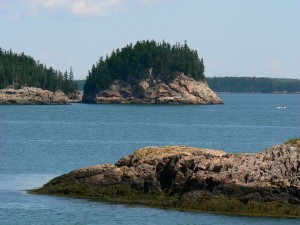We rose at dawn and drove to a rocky beach south of Steuben, Maine. After carefully packing our kayaks with safety gear, food, water, and extra clothing, we donned the thick black wetsuits needed to paddle safely in 50 degree waters, launched from the rocky beach, and paddled south along Petit Manan Point. Even as we did so, we monitored the weather on the VHF radio, as this area is renowned for fog and turbulent sea conditions. The mainland slipped away behind us. The ocean yawned wide in front of us. With excitement and trepidation, we continued paddling south for two miles along the shoal that frequently provides some of the diciest sea conditions along the coast of Maine.
Manan means “island out to sea” in Micmac — and, amidst that landscape in which the mainland recedes in all directions, the name seems highly appropriate. The 120 foot spire of Petit Manan lighthouse provides a singular reference point amidst that big sea. We diverted our course to the west to trace the shoreline of adjacent Green island, our eyes alert for what we had come for. But there were only hordes of jeering gulls on the shoreline.
Then we moved onto Petit Manan itself, which is connected to Green, at low tide, by a series of bouldered ledges. On this island which has been called, “one of the most important seabird colonies in Maine,” we saw guillemots, cormorants, eiders, terns, and laughing gulls, but none of the little black and white penguin-cousins we had come for. We saw the puffin blinds used by the U.S. Fish and Wildlife Service naturalists to study and monitor the puffins. We scrutinized the rocky shoreline for sights of puffin nests. We scanned the sky and the water for puffins. And saw none.
By this time, we had circled three-quarters of the way around Green and Petit Manan. On this, our second trip out to the island, we had just about resigned ourselves to not seeing the puffins. Then we rounded the southern tip to the area of Petit Manan reef. Suddenly the sky was alive with Atlantic puffins torpedoing through the air as they circled from the cliffs to our left, swooped out over the the shallow waters of the reef, and then wheeled back toward the lighthouse. These puffin “wheels” I later read are common in puffin areas where gull predation is high.
We rested our paddles on our kayaks, marveling at the sight, and ineptly trying to take photos of the fast-moving birds. Puffin flight is best described as frantic. These foot-tall relatives of penguins have short wings and long stout bodies more adapted to swimming than flying. In flight, their wings, which flap at up to 400 beats per minute, are only a blur. The short wings don’t allow puffins to soar or float in the air. Instead, they dive-bomber through it at speeds of 40 to 50 miles per hour.
Seconds turned to minutes. The sun filtered more brightly through the clouds. Gentle green swells lifted and lowered us as they passed toward the cliffs. We pulled our eyes out of the viewfinders of our cameras and lowered them from the sky to the water. The tidal current had slowly eased us to the north. The water around us was suddenly, magically full of puffins.
Undisturbed by us, seeming to accept our presence, they drifted in groups, preening and puffing and dipping their heads beneath the surface. For a time, we were lost to the human world and joined the puffin one. There, as we drifted, it was possible for a few moments to forget that we were not puffins. To forget that the gentle sea that stirred around us was not our home.
Of Maine’s 4,000 islands and ledges, puffins nest on fewer than ten. Once they leave those nests, they spend up to five years far out at sea before ever returning to land. To say they live on the periphery of human civilization is an understatement. To spend a few minutes among these rare and marvelous birds is a privilege and a gift. Part of that gift is the reminder that beyond the human world lies a much larger one, of which both we and the puffins are just a tiny part.
Resources:
Maine Coastal Islands National Wildlife Refuges
Maine Birding.Net: Atlantic Puffin
Seabird Photography
Bird Fact Sheet: Atlantic Puffin




